Give me a little more time and I can generate a Drive Potential table that DOES perfectly reflect the code: 1 @ +200 tons per letter formula.
All of the changes are made in
BLUE, to help make them more apparent and easy to spot.
Drive-J @ 2000 tons is "-" instead of 1.
Drive-W @ 800 tons had a poor print quality "5" so I just replaced it, but it IS CORRECT in the original. It's the Drive-X/Y @ 800 tons that were "cheating" and needed to be rewritten to follow the formula.
Also, to get to a 5000 ton hull, you would need a Drive-(Z+1) in order to reach (Z+1)=25*200=5000 tons when following the formula correctly and consistently (oops

).
For those people "keeping score" on How Right Or Wrong™ the entire code: 1 per 200 tons per letter drive postulate is ... I actually only needed to CHANGE:
- 2 codes for 800 tons (X, Y)
- 4 codes for 1000 tons (W, X, Y, Z)
- 4 codes for 2000 tons (J, X. Y, Z)
- 3 codes for 3000 tons (X. Y. Z)
- 2 codes for 4000 tons (Y, Z)
- 1 code for 4800 tons (not 5000 tons) (Z)
Everything else in the table FITS the code: 1 per 200 tons per letter drive postulate.
It's only the "bottom right" of the table where
Things Went Wrong™.
I'm completely convinced that THAT specific instance was someone "rounding off" (for convenience) something that shouldn't have been rounded off.
J=9
9*200=1800
Since there was no 1800 ton hull, but there was a 2000 ton hull in the table, someone either thought "eh, close enough" ... OR ... it's literally a typo (should have been a "-" but a "1" got put there instead and the editor didn't catch the error).
Notice that the 1000 ton row is 5 drive letters per +1 code.
So logically, the 2000 ton row ought to be 10 drive letters per +1 code.
However the 2000 @ J makes for 11x code: 1 instead of 10 ... so it breaks the pattern and is probably an error/misprint.




